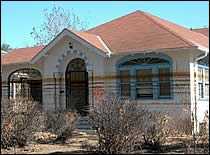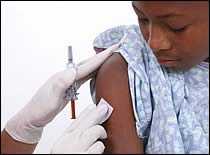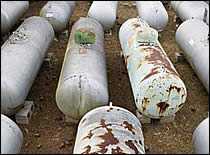After a Flood
On This Page
Precautions When Returning to Your Home
Electrical power and natural gas or propane tanks should be shut off to avoid fire, electrocution, or explosions. Try to return to your home during the daytime so that you do not have to use any lights. Use battery-powered flashlights and lanterns, rather than candles, gas lanterns, or torches. If you smell gas or suspect a leak, turn off the main gas valve, open all windows, and leave the house immediately. Notify the gas company or the police or fire departments or State Fire Marshal's office, and do not turn on the lights or do anything that could cause a spark. Do not return to the house until you are told it is safe to do so.
Your electrical system may also be damaged. If you see frayed wiring or sparks, or if there is an odor of something burning but no visible fire, you should immediately shut off the electrical system at the circuit breaker.
Avoid any downed power lines, particularly those in water. Avoid wading in standing water, which also may contain glass or metal fragments.
 You should consult your utility company about using electrical equipment, including power generators. Be aware that it is against the law and a violation of electrical codes to connect generators to your home's electrical circuits without the approved, automatic-interrupt devices. If a generator is on line when electrical service is restored, it can become a major fire hazard. In addition, the improper connection of a generator to your home's electrical circuits may endanger line workers helping to restore power in your area. All electrical equipment and appliances must be completely dry before returning them to service. It is advisable to have a certified electrician check these items if there is any question. Also, remember not to operate any gas-powered equipment indoors (see also Carbon Monoxide Poisoning ).
You should consult your utility company about using electrical equipment, including power generators. Be aware that it is against the law and a violation of electrical codes to connect generators to your home's electrical circuits without the approved, automatic-interrupt devices. If a generator is on line when electrical service is restored, it can become a major fire hazard. In addition, the improper connection of a generator to your home's electrical circuits may endanger line workers helping to restore power in your area. All electrical equipment and appliances must be completely dry before returning them to service. It is advisable to have a certified electrician check these items if there is any question. Also, remember not to operate any gas-powered equipment indoors (see also Carbon Monoxide Poisoning ).
For more information, see Protect Yourself and Others From Electrical Hazards After a Disaster and Reentering Your Flooded Home .
Cleanup
- Put on the personal protective equipment to protect your eyes, nose, mouth, and skin. (https://www.cdc.gov/mold/cleanup-guide.html)
- Remove standing water and wet materials. Use a wet vacuum to remove water from floors, carpets, and hard surfaces. Dry your home and everything in it as quickly as you can – within 24 to 48 hours if you can.
- Open all doors and windows when you are working and leave as many open as is safe when you leave.
- Open inside doors, especially closets and interior rooms, to let air flow to all areas. Take doors off their hinges if you need to.
- Open kitchen cabinets and bathroom vanity doors; remove drawers, wipe them clean, and stack them to dry.
- Open the attic access to let air flow to the attic. Before you open the attic door, make sure nothing will fall on you.
- When electricity is safe to use, use fans and dehumidifiers to remove moisture. Do not use fans if mold has already started to grow, because the fans may spread the mold.
- Clean with water and a detergent. Remove all mold you can see. Dry right away.
- If you use cleaning products, do not mix cleaning products together. DO NOT mix bleach and ammonia because it can create toxic vapors.
- Painting or caulking over mold will not prevent mold from growing. Fix the water problem completely and clean up all the mold before you paint or caulk.
- Throw away items that can’t be cleaned and dried. Throw away anything that was wet with flood water and can’t be cleaned and dried completely within 24 to 48 hours. If you have precious items that you want to preserve, follow these guidelines from the Smithsonian Institute: https://www.si.edu/mci/english/learn_more/taking_care/index.html
See also Mold After a Disaster .
Immunizations 
Outbreaks of communicable diseases after floods are unusual. However, the rates of diseases that were present before a flood may increase because of decreased sanitation or overcrowding among displaced persons. Increases in infectious diseases that were not present in the community before the flood are not usually a problem. If you receive a puncture wound or a wound contaminated with feces, soil, or saliva, have a doctor or health department determine whether a tetanus booster is necessary based on individual records.
Specific recommendations for vaccinations should be made on a case-by-case basis, or as determined by local and state health departments.
Swiftly Flowing Water
If you enter swiftly flowing water, you risk drowning — regardless of your ability to swim. Swiftly moving shallow water can be deadly, and even shallow standing water can be dangerous for small children. Cars or other vehicles do not provide adequate protection from flood waters. Cars can be swept away or may break down in moving water.
Chemical Hazards
Use extreme caution when returning to your area after a flood. Be aware of potential chemical hazards you may encounter during flood recovery. Flood waters may have buried or moved hazardous chemical containers of solvents or other industrial chemicals from their normal storage places.
 If any propane tanks (whether 20-lb. tanks from a gas grill or household propane tanks) are discovered, do not attempt to move them yourself. These represent a very real danger of fire or explosion, and if any are found, police or fire departments or your State Fire Marshal's office should be contacted immediately.
If any propane tanks (whether 20-lb. tanks from a gas grill or household propane tanks) are discovered, do not attempt to move them yourself. These represent a very real danger of fire or explosion, and if any are found, police or fire departments or your State Fire Marshal's office should be contacted immediately.
Car batteries, even those in flood water, may still contain an electrical charge and should be removed with extreme caution by using insulated gloves. Avoid coming in contact with any acid that may have spilled from a damaged car battery.
For more information about possible dangers posed by chemical leaks and spills, see the Chemical Emergencies Web site.
Additional Information
- Page last reviewed: August 28, 2017
- Page last updated: September 22, 2017
- Content source:


 ShareCompartir
ShareCompartir

